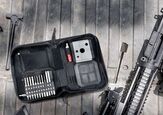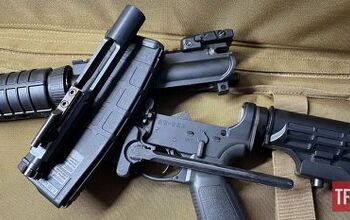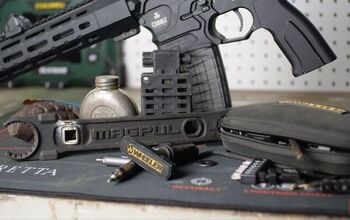Best Optic for the AR-15

Best Optic for the AR-15 - Primary Arms Compact PLxC 1-8X24 FFP
Picking one optic to rule them all for the AR-15 has to be one of the more difficult tasks in all of the “top ten” and “best of” articles a gun writer can take on. It’s not that I’m worried about being agreed with because that ship sails the moment you take the job. The challenge comes mostly from a desire to be as helpful as possible while actually committing to an answer other than saying it comes down to personal preference. Further exasperating the issue is that categories of optics alone can be a hotly contested debate, much less the optics themselves. As I rip off that best optic for the AR-15 bandaid and stare death in the face, I quote a writer much better than I when I say, “Once more unto the breach, dear friends, once more…”
And the winner is…
The Primary Arms Compact PLxC 1-8X24 FFP low-power variable optic or LPVO is a first focal plane scope and part of Primary Arms’ top-tier PLx optics line that the company claims will meet the exacting demands of professional use through impeccable glass clarity and advanced features. Well, spoiler alert: we wouldn't be having this conversation if the PLxC didn’t live up to that assertion.
Making Comparisons
The most conspicuous observation when initially getting my hands on the Primary Arms PLxC is the compact nature of the optic, with its overall length of 9.28 inches compared to the 10.1 inches of the Nightforce ATACR 1-8 and the Vortex Razor Gen III 1-10 that she told you not to worry about. Additionally, the ATACR weighs 20 ounces and the Razor 21.5, while the PLxC comes in at 16.95 ounces. I offer this information merely for scale and don’t mean to make one-to-one comparisons here as both of those other optics have 34mm tubes compared to 30mm on the PLxC, with the Razor featuring additional magnification. That being said, I am comfortable speaking about these optics in a similar context because, as someone who loves using the Nightforce and the Vortex, I’m happy to report that, in my opinion, the Primary Arms PLxC has stepped into that ring, albeit at the much more approachable price tag of $1499.99.
Here’s what you get…
As this isn’t so much a traditional review by any means, I’ll make the unboxing short and sweet by saying my version of the Primary Arms PLxC with the ACSS Griffin MIL M8 Reticle comes in a premium box and includes standard documentation, microfiber cloth, CR2032 battery, an Allen wrench for resetting zero, a threaded hood that may be useful but I was quick to discard in defense of the PLxC’s petite footprint, and an optional tactical elevation turret, which I immediately installed in place of the capped version. Herein lies the only complaint I can muster, and it’s truly a nitpick to seem fair in an otherwise glowing experience with the optic. The PLxC comes with one of those rubber bikini lens cover things that I’d just as soon turn into a slingshot before actually using it on my optic. Back in the box that went, replaced by a pair of Butler Creek flip caps in the front and rear.
Why an LPVO?
Before we go on, let’s take a moment to discuss why I picked an LPVO for the top spot. A solid AR-15, like my BCM RECCE 14, can take targets in excess of 500 yards. I’ll take the easy road with more magnification, clarity, and information on the long end that a red dot and magnifier combination cannot provide. This isn’t to mention that if zombies begin roaming the earth, I’d also like better positive ID for the brain bucket challenge. In essence, and with full recognition of give and take, I’m trying to get every last bit out of the rifle within its respective range, and I feel I can do that with the Primary Arms PLxC 1-8.
Addressing other categories of optics, I do appreciate great red dot or holographic sights like an Aimpoint T2 or an EOTech, and my astigmatism gravitates towards the etched clarity of prisms like the Trijicon ACOG, the Elcan Specter, and in recent years, the Primary Arms SLx and GLx MicroPrisms. But in choosing one optic, I wanted the flexibility of having 1x through 8x at my fingertips, crisp, clear glass at range, and the peace of mind that comes from knowing it’s all available to me even if my battery dies.
PLxC 1-8 ACSS Griffin MIL M8 Specifications:
| Battery Type | CR2032 3V Lithium Coin |
| Click Value | 0.1 Mil |
| Exit Pupil Diameter | Low: 8mm / High: 3mm |
| Eye Relief | Low: 3.2” / High: 3.7” |
| Field of View @ 100yards | Low: 121’ / High: 14.6’ |
| Focal Plane | First Focal Plane |
| Illuminated | Yes |
| Length | 9.28” |
| Weight | 16.95 Ounces |
| Magnification | 1X - 8X |
| Mount Compatibility | 30mm |
| Night Vision Compatible | Yes |
| Objective Diameter | 24mm |
| Optic Series | Plx |
| Reticle | ACSS Griffin MIL M8 |
| Reticle Color | Red |
| Reticle Type | MRAD |
| Total Elevation Adjustment | 100 MOA/29.1 MIL |
| Total Windage Adjustment | 100 MOA/29.1 MIL |
Reticle Design
Primary Arms has long been known for its innovative Advanced Combined Sighting System or ACSS Reticles. The ACSS Griffin MIL M8 is a new addition to the line designed specifically for the 1-8x magnification range. At 1x, minute information provided by the ACSS Griffin MIL M8 fades away, clearing a path for CQB with an illuminated horseshoe and chevron circle of death for rapid target acquisition. Here’s where we run the Primary Arms PLxC 1-8 similar to a red dot.
Since we’re dealing with a first focal plane optic, subtensions will be accurate throughout the magnification range, which works very well, but let’s face it, most people will grab hold of the convenient throw lever and crank that smooth ring to 8x at distance, bringing the ACSS Griffin MIL M8’s full feature set into view with the fine details of its MIL grid, precise chevron aiming point, and vertical and horizontal stadia for quick auto ranging estimations. Additionally, you can use the intuitive MIL grid to range targets of known size with some very simple math.
Zeroing the Primary Arms Compact PLxC 1-8X24 ACSS Griffin MIL M8
While the PLxC manual offers some insight into suggested zeroing distances and respective holdovers for using it like a bullet drop compensation (BDC) reticle, the magic of a MIL reticle like this is its versatility, providing the best results possible for the individual shooter by allowing them to tailor the reticle to their needs. For example, on an AR-15, I like to zero my rifle for maximum Point Blank Range (PBR) using a chronograph and load data to determine a point-of-aim point-of-impact zone within an approximate eight-inch circle. My rifle had an average velocity of 2902fps with some 55gr M193 I had lying around. Plugging appropriate data into a ballistic chart, I determined that a 37-yard near zero would give me a 265-yard far zero while keeping my projectile within my designated eight-inch circle for an additional forty yards. This means I can take a combat-effective shot by simply lining up the crosshairs all the way out to 305 yards. However, the ACSS Griffin MIL M8 uses the same ballistic chart to map further distances to MILs, which I can either hold over or dial on the elevation turret. I like to create a diagram-like cheat sheet of my reticle with these distance notes written on it and keep it taped to the inside of my rear scope cap.
The mechanical zeroing process is easy. Shoot your best three-shot group, adjust your elevation and windage turrets until your group lands in your designated bullseye, then use the provided Allen wrench to gently remove the turrets, reset them to zero, and lower them back into place without causing any shift in your adjustments. Tighten down the three Allen screws on each turret, and you’re good to go.
Turrets
The installed tactical elevation turret and caps are knurled to perfection, making adjustments and removing the covers on the Primary Arms PLxC 1-8 easy. What stands out to me is the level of tactile click porn as you dial, which can be effortlessly done by sound or feel in utter darkness. I’ve had significantly more expensive optics with excellent turrets that weren’t this good. Tracking was right on, using a box test to gauge the accuracy of the elevation and windage adjustments at fifty yards. While the turrets do not feature a zero-stop or locking mechanism, the windage is typically capped, and elevation is firm enough to instill trust that a deliberate act must be imposed to move the dial.
Illumination
The Primary Arms PLxC 1-8 features ten brightness settings, lighting up the horseshoe and chevron in red. While this PLxC is not advertised as daytime bright, I’m pleasantly surprised by its visibility under most conditions. Illumination was visible to my eye under heavy sunlight but was far from nuclear. That being said, when the background is incredibly bright, the thick horseshoe and chevron provide a clear contrast that makes target acquisition a breeze. Primary Arms also made sure the PLxC includes a feature I love: off positions between each setting that allow me to leave the illumination deactivated but adjacent to the level I want the quickest access to, avoiding the need to dial it all the way back each time.
Optical Quality
The Primary Arms PLxC uses premium-grade Japanese ED glass, demonstrating enhanced clarity, light transmission, natural colors, and resistance to chromatic aberration from edge to edge, something the photographer in me is thankful for. I found this true throughout the magnification range. At 1x, the image looks as unmagnified as I’ve ever seen, adding to another unique quality of the PLxC: a slim bezel around the ocular lens that causes the body of the scope to vanish when I pull the rifle into my line of sight. The effect is that of a crisp image and reticle floating effortlessly suspended in mid-air. I did kill that buzz a little by adding the rear flip cover, but the effect is still enough to appreciate.
The ultra-wide field of view is impressive for an LPVO, and while I’m not one to measure out and confirm a manufacturer’s advertised eye relief, I found it, and the eye box, very forgiving and easy to work with from any position, even with the narrowing exit pupil at 8x magnification with the PLxC’s 24mm objective.
Conclusion
The Primary Arms PLxC 1-8 is a compact and lightweight optic with high-quality glass, excellent mechanical ergonomics, usable illumination, and an intuitive ACSS reticle. No optic is meant to do everything the best. However, I chose the PLxC as my number one pick because I wanted something that does everything well and, most importantly, helped me take advantage of the entire range of capabilities the AR-15 has to offer. Another factor was the price, which is admittedly not inexpensive but not stratospherically out of reach like some of the options I feel the PLxC competes with, making this optic an excellent value. While time will tell on the durability front, I can’t say I’ve discovered any particular weak points so far, and Primary Arms has built a reputation for quality, especially in its PLx line. I’ve been testing the PLxC for just over a month now, which may not seem like a long time, but considering I live and work on a ranch, the BCM RECCE 14 I have it mounted on is my everyday carry, so it’s safe to say the rifle and optic have taken their fair share of bumpy rides through the pasture and practical, real-world use.
I’d recommend the Primary Arms PLxC 1-8X24 FFP as the best optic for an AR-15 and anyone looking for a high-quality shooting experience at the range, in 3-gun competition, or everyday duty use. Let me know your thoughts in the comments below, and as always, happy shooting.

2A enthusiast. If it shoots, I get behind it, from cameras to firearms. | DTOE = Darwin's Theory on Everything | Instagram, YouTube, X: @dtoe_official
More by Darwin N.



















![[SHOT 2025] RISE Armament RA-100 Two-Stage AR-15/AR-10 Trigger](https://cdn-fastly.thefirearmblog.com/media/2025/01/23/12371/shot-2025-rise-armament-ra-100-two-stage-ar-15-ar-10-trigger.jpg?size=350x220)





![[SHOT 2025] The CarbonMax From Wraithworks](https://cdn-fastly.thefirearmblog.com/media/2025/01/21/11501/shot-2025-the-carbonmax-from-wraithworks.jpg?size=350x220)
![[SHOT 2025] Barrett Firearms Adds New MRAD Barrel Options](https://cdn-fastly.thefirearmblog.com/media/2025/01/25/17394/shot-2025-barrett-firearms-adds-new-mrad-barrel-options.jpg?size=350x220)



![[SHOT 2025] AAC's New Ranger 5 Reduced Back Pressure Silencer](https://cdn-fastly.thefirearmblog.com/media/2025/01/28/23344/shot-2025-aac-s-new-ranger-5-reduced-back-pressure-silencer.jpg?size=350x220)

Comments
Join the conversation
LPVO's have their place but $1500 is ridiculous for what you get. The ones that cost more are even more ridiculous. I prefer FFP scopes but I don't understand FFP LPVO's, I own a few and they are either at 1 or max magnification. I don't think there's any use for everything in between eliminating the need for a FFP.
Why dodge listing the price?